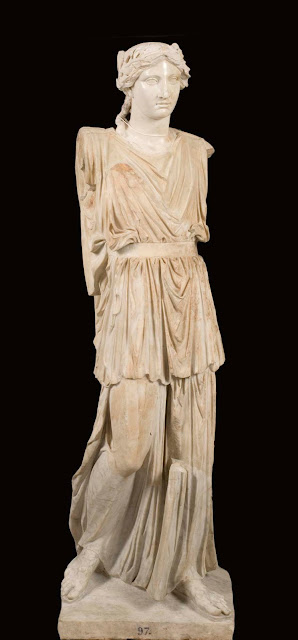The bronze bust above is called a "Laocoonte" at the Prado, a figure based on the very famous marble group of the Laocoön which was excavated in Rome early in the 16th century and thereafter displayed at the Vatican (as it still is today). In the absence of documentation, Spanish curators have entertained several theories about the origin of this bronze bust. It was formerly believed to have been cast in Italy in the 17th century, purchased there and brought back to Spain by Velázquez. Another view holds that it was cast in Spain early in the 18th century, perhaps based on some lost model brought from Italy.
Below are a number of other Prado sculptures with complicated, composite relationships to the workshops of Imperial Rome and the workshops of Renaissance or Baroque Italy.
 |
| Bust of a woman marble 2nd century AD (head) 16th century (bust) Prado |
 |
| Bust of Emperor Antoninus Pius AD 140-150 (head) 16th century (bust) Prado |
 |
| Bust of the Homeric hero Diomedes AD 140-150 (head) 16th century (bust) Prado |
 |
| Bust of an elderly Roman 25 BC (head) 16th century (bust) Prado |
 |
| Apollo AD 130-140 (Roman fragments from several works) 17th century (assembled in Italy) Prado |
 |
| Mercury AD 150-200 (Roman torso) 17th century (Italian additions - new head, arms, legs, base) Prado |
 |
| Paris & Eros AD 150 (Roman fragments from several works) 17th century (assembled in Italy) Prado |
The final group of marbles, shipped like the others in large batches from Italy to Spain, have not been identified as composites, but these too would certainly have undergone "improvement" after discovery. At the very least they received new noses, since in almost no case did antique marble heads survive with noses intact.
 |
| Bust of young Bacchus Rome 115-100 BC Prado |
 |
| Bust of a woman Rome AD 100-110 Prado |
 |
| Memorial bust of a young man Rome AD 200-210 Prado |
 |
| Bust of a woman Rome AD 140-150 Prado |
 |
| Bust of a young woman Rome AD 225-235 Prado |

